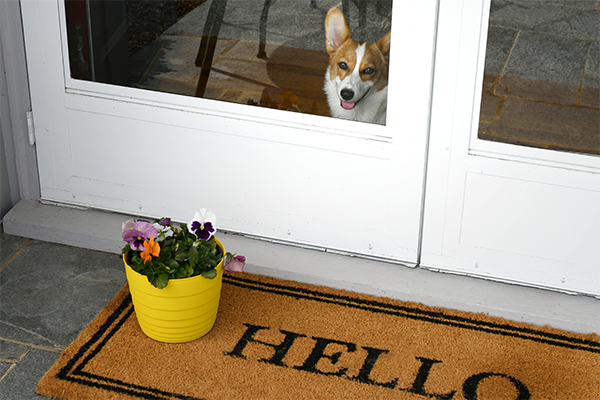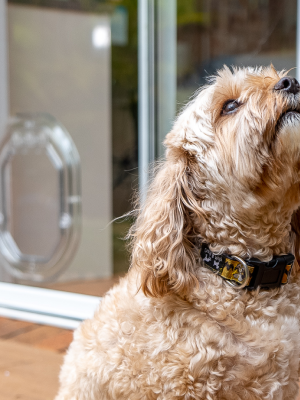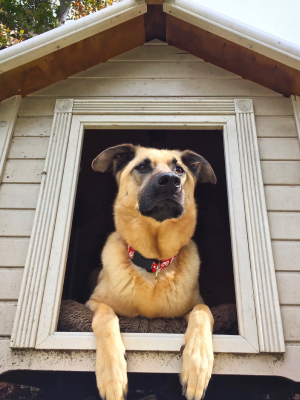
Dogs are loyal companions and bring joy to our lives, but sometimes their behaviour can be challenging. One common problem dog owners face is their furry friend’s incessant door scratching.
Our Blog
Our Blog
6/3/23
How to Stop Your Dog From Scratching the Door
Dogs are loyal companions and bring joy to our lives, but sometimes their behaviour can be challenging. One common problem dog owners face is their furry friend’s incessant door scratching. While it may seem harmless, door-scratching can cause damage to the door. It can also disrupt household peace, and even lead to injury to the dog. In this article, we’ll explore why dogs scratch doors. We’ll also discuss how you can use training, tools and toys to stop it. Whether you are a new dog owner, or have had your furry friend for years, these tips will help you stop your dog from scratching at the door.
Why Does My Dog Scratch at the Door?
Your dog may be scratching your doors for many reasons, including boredom, anxiety, or a desire for attention. Understanding why your dog is scratching your doors is the first step to choosing the right solution. Let’s take a closer look at some of the reasons why your dog may be scratching:
- Learned behaviour: A learned behaviour refers to behaviour that has been rewarded and encouraged. If you show your dog that they can get what they want they will repeat the behaviour. This behaviour is corrected through training.
- Separation anxiety: Many dogs experience separation anxiety, a behavioural disorder that causes high-stress levels and discomfort when separated from their owner. When experiencing anxiety, a dog may bark more or destroy objects around the home. This disorder is typically displayed in dogs who have experienced trauma, have not been socialised or do not have proper training. If you suspect your dog has separation anxiety, consider filming them while you are absent. This can help you gauge their behaviour and pass on information to professional trainers where necessary. This behaviour is typically corrected through training and stimulation.
- Toilet-needs: Your dog may be scratching the door to show they need to go to the toilet. This can be due to a lack of regular toilet breaks or learned behaviour. This behaviour is corrected through training and helpful tools such as dog doors.
- Illness: If the scratching has begun suddenly, it may indicate underlying health problems. Dogs have high pain thresholds and typically wait a long time before exhibiting any symptoms when experiencing physiological or psychological pain. Scratching at the door may be an early signal of discomfort. Always take your dog to the vet to ensure that any underlying causes have been ruled out.
- Under-stimulation: All dogs require physical and mental stimulation, with amounts varying depending on age, breed, temperament and more. Without proper stimulation, dogs can become stressed or bored. Scratching the door may simply be your dog’s favourite past-time. This behaviour is corrected through training and stimulation.
- Over-stimulation: Inversely, if a dog is confronted with sudden changes, it may exhibit stress and destructive behaviours. This could be due to increased noise, an inconsistent schedule, or any other form of over-stimulation. This behaviour is corrected with regular exercise and an adjustment to their environment.
No matter the reason, the golden rule when addressing any door-scratching behaviour is to avoid giving it any attention. This means waiting till your dog has stopped scratching to attend to their needs and leaving the room if necessary. This is just one basic form of training that you can use.

Training Your Dog Not to Scratch at the Door
The good news is that there are several effective training methods to get your dog to stop scratching at the door. The most popular methods used are firm correction, manage excitement and distract and deter training.
Firm Correction Training
This training method focuses on discouraging and correcting behaviour. Please note that this method requires that your dog understands basic commands such as ‘sit’ or ‘lie down’. Additionally, you must have treats on hand.
-
- Leave your dog in a closed room and listen from outside the door.
- When you hear scratching noises, open the door and look directly into your dog’s eyes.
- Firmly say ‘No’ while opening the door. Be mindful not to shout at your dog. Consider having a leash on your dog during this training. This way, you can physically redirect your dog while giving the command.
- Wait a few seconds and let your dog calm down as you hold your stance and gaze. Once the dog is calm, it will cease scratching and attempt to win you over.
- Command your dog to either ‘sit’ or ‘lie down’ and reward them with a treat. This is to highlight what happens when good behaviour is used.
- Repeat this training for 10 minutes each day for two weeks. As the scratching decreases, reduce the use of treats until no food is required for positive behaviour.
Manage Excitement Training
This training method focuses on learning how your behaviour can affect your dog. Please note that this training method requires some types of stimulation toys that are safe for unsupervised use.
-
- Dogs understand schedules and routines and will be able to read your behaviour when you prepare to leave home. This can increase their anxiety in the lead-up to your leaving. To avoid this association, be mindful of your behaviour when leaving and keep affectionate farewells to a minimum.
- Ignore any attention-seeking behaviour from your dog; instead, train them to be content with being alone.
- Provide stimulation, such as food puzzles, to distract and entertain your dog in your absence.
- Keep your return routine as relaxed as your departing routine. Wait a few minutes after entering the home before greeting your dog. Do not show vocal or physical excitement when returning home.
- Wait for your dog to calm down before taking them for a walk. This will ensure they do not associate excitable behaviour with rewards.
- Continue to follow through on this behaviour, repeating each step to help develop healthy habits.
Distract and Deter Training
This training method focuses on finding healthy alternatives to the scratching behaviour. Please note that this method requires tools and alternative stimulation.
-
- Exercise regularly to reduce pent-up energy. Consider taking a tennis ball or other favourite toy to throw while walking, as short sprints can provide a serious workout for more energetic pups.
- Consider purchasing and installing a pet door to give your dog more freedom.
- Leave music or a podcast playing quietly while you’re gone to simulate human company.
- Invest in a soothing pheromone dispenser to reduce stress from separation anxiety.
- Remember to follow through on training and remain patient, as reconditioning can take time.
Training a dog requires a lot of patience and understanding. If you feel under-equipped or aren’t getting the desired results, consider contacting a professional training service. Professional dog trainers can help identify the root cause of door-scratching issues and develop a customised training plan for your dog. Professional dog training is an investment in your dog’s long-term health and happiness.
Tools to Stop Your Dog Scratching The Door
Many training methods can benefit from using tools. Great tools for preventing your dog from scratching the door include dog doors, door protectors, deterrents and more.
Install a Dog Door
Sometimes, the best way out of a difficult situation is through. Dog doors are the perfect solution for dogs that desire more freedom.
Dog doors can be installed in all types of doors, including glass, wood and screen doors. They can also be installed with secure microchip systems to ensure that only your dog can enter and exit the home. We also offer custom dog doors if you have a specific type in mind.
Create a Barrier
If you’re happy to have the door open, but don’t want your dog entering the room, consider a dog gate. This will let your dog see you from the other room and reduce separation anxiety.
Consider Adding a Dog Door Protector
A door protector or vinyl film covering are designed to create a protective barrier between your dog’s claws and the door. They can deter scratching due to their unappealing slippery texture. Additionally, you can use these protectors to block the dog’s view of the outside. This can be beneficial for glass doors where the dog may be responding to outside stimuli such as pedestrians.
Use Pet-Safe Dog Deterrent
Natural dog repellents such as citronella oil, citrus, essential oils and vinegar are great ways to keep your dog away from specific areas or things. Using a pre-made or homemade natural repellent can help stop your dog from going near the door.

It’s important to remember that while tools can be useful, they should be combined with training and positive reinforcement techniques to effectively correct the behaviour. Additionally, doors, deterrents, barriers and protectors address the symptom, not the root cause of scratching. Sometimes alternative activities and enrichment can eliminate the behaviour entirely.
Providing Alternatives
By offering your dog alternative ways to express their needs and providing them with a stimulating environment, you can help them feel more content and reduce the likelihood of door scratching in the first place. Providing alternatives goes hand-in-hand with the distract and deter training method. The best alternatives you can consider for your pup are exercise and enrichment.
Try Some Dog Exercises
Dogs are playful, energetic creatures by nature. Taking your dog out for regularly-scheduled exercise is crucial to their mental and physical health. It also has added benefits for your own health, making it a win-win. Some ways to get your pup moving include:
-
- Walking: At least once daily walks are recommended for dogs, with times and frequency depending on breed and temperament. Walking your dog can help keep them healthy and mentally stimulated by introducing them to new sights and smells.
- Fetch: A classic physical exercise, playing fetch with your dog is a great way to burn energy and improve their obedience skills.
- Agility training: For the super-involved pup parent, consider placing down or finding an obstacle course. This will offer a fun and challenging twist for your pup.
- Swimming: This low-impact exercise is a great option for dogs with joint issues. It also gives you a chance to cool down and join in on the fun.
- Hiking: Take walking to the extreme on a hike with your pup. Hiking offers challenging terrain and new adventures.
Get Playful With Dog Enrichment Toys

When you’re not interacting with your dog, giving them mentally stimulating options around the home is important. Some fantastic toys to consider include:
-
- Puzzle toys: These toys require your dog to solve a puzzle to get to a treat or food. This provides mental stimulation and a challenge. Examples include treat-dispensing balls or cubes and puzzles with sliding or spinning parts.
- Chew toys: Chewing is a natural behaviour for dogs, and providing them with various chew toys can help keep them entertained and reduce destructive chewing behaviours. Examples include flavoured rubber toys or durable nylon bones.
- Scent-based toys: Dogs have an incredible sense of smell, and toys that utilise scent can give them a unique and engaging experience. Examples include toys filled with dried meat or scented with essential oils.
- Ball launchers: These toys can keep your dog entertained for hours as they chase after a ball launched from the device. They provide a great way to get your dog exercise and mental stimulation.
Following the tips outlined in this article, you can train your furry friend to stop scratching the door and improve their behaviour, leading to a happier and healthier relationship with your dog. Contact us today if you’re interested in discussing how dog doors can help prevent your dog from scratching your doors.
Latest Posts
Latest Posts
Questions? We’re here to help.


